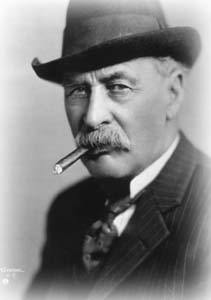![[Metroactive Arts]](/arts/gifs/art468.gif)
![[Metroactive Arts]](/arts/gifs/art468.gif)
[ Arts Index | Metro | Metroactive Central | Archives ]
Filling the Basin
The new television documentary 'Cadillac Desert' traces the damming of the West
By Michael Learmonth
WHEN WILLIAM Mulholland visited Yosemite Valley 70 years ago, he was moved. So moved that he said if he were in charge, he would send photographers into the valley to shoot pictures day and night for an entire year. He would publish the photos in books and send them to every library in the world. Then, Mulholland said, "I would build a great dam and stop all the goddamn waste."
Imagine, water-skiing on Yosemite Lake.
The legendary chief of the Los Angeles Water Department thought of himself as a conservationist and believed that every drop of fresh water that ran out to the sea without being diverted, dammed and stored was water wasted. He built the 230-mile aqueduct from Owens Valley to Los Angeles County that allowed a small town with a dry river to grow into a megalopolis. After draining Owens Lake, the City of Los Angeles stretched 300 miles to the east to pipe in water from the Colorado River, and 600 miles to the north to tap the Feather River.
"Mulholland's Dream" is the appropriate title of the first installment of Cadillac Desert, a four-part documentary that delves into the colossal political forces and egos that conquered the West's wild rivers and brought us a verdant Central Valley, Phoenix, Las Vegas and L.A. The series was written and produced by Academy Awardnominated filmmaker Jon Else and based on the 1986 book by Marc Reisner. It will air on consecutive Mondays beginning June 23 at 9pm on KTEH-TV (Ch. 54).
The book Cadillac Desert is a social history of the politics of water in the United States and the environmental destruction wreaked by dams. It is also a history of the Bureau of Reclamation in the Department of the Interior, which undertook some of the biggest public works projects in U.S. history. The book had a great impact on public officials who had been slow to accept the end of the era of big water projects. Today, even employees of the Bureau of Reclamation are urged to read it.
"It offered a great deal of insight," says Bob Gross, board member of the Santa Clara Valley Water District. "My question has always been, Will the leadership of California pay attention?"
Official web site for the show.
Home page for KTEH, the station showing the program.
A rather too complimentary biography of William Mulholland, prepared by the Los Angeles Department of Water and Power.
Information about environmentalist David Brower.
THE DOCUMENTARY begins with Mulholland, who scoured the West for sources of water as L.A.'s building boom in the 1920s and '30s spread green lawns, palm trees and swimming pools across 400 square miles of parched desert.
Hoover Dam, built at the height of the Depression, was the biggest man-made structure in the world. It tamed a section of the Colorado River that was so wild it appeared as "unexplored" on maps just a few years earlier. The 100-mile reservoir behind Hoover is so heavy it bends the earth's crust, causing miniearthquakes.
After Hoover came the even bigger Grand Coulee on the Columbia River and Glen Canyon Dam upstream from the Hoover on the Colorado. The Glen Canyon Dam created Lake Powell, which loses two times as much water through evaporation as the entire city of L.A. consumes each year. At one point, the dam-building pharaohs were erecting the three largest structures in the world--simultaneously.
Else treats the dam builders and the dam haters with equal compassion. The documentary is interspersed with revealing conversations with Mulholland's granddaughter, Catherine Mulholland; the descendants of Owens Valley ranchers who watched their land dry up; Floyd Dominy, the legendary head of the Bureau of Reclamation; and Barry Goldwater, whose pure brand of conservatism makes him an enigma to today's "family values" Republicans.
Dominy, who headed the Bureau of Reclamation from 1959 to 1969, remains in his old age feisty and proud of his accomplishments: "I have no apologies. I was a crusader for the development of water. I was the Messiah. I was the evangelist who went out and argued persuasively for the harness of water for the benefit of people."
In a remarkably candid interview in his home in Phoenix, Goldwater expresses some regret about his role in damming the Colorado: "I have to be honest with you. I'd be happier if we didn't have the lake. Glen Canyon used to be filled with beavers. There are no beavers in there anymore."
The Glen Canyon Dam covered a section of the Colorado River that not 200 white Americans had ever seen. One of them was seminal environmentalist David Brower, first executive director of the Sierra Club and founder of the modern-day conservation movement.
But by the time Brower had toured the 600-foot-deep canyon and its tributaries, he had already agreed not to oppose the dam in exchange for the Bureau of Reclamation's promise not to build a dam on the Green River. It is a decision that still haunts him in his 90s: "An exquisite place, just about as beautiful a thing as the Creator ever dreamed up. I did have this last desperate hope that we could stay the closing of the dam. In January 1963, I failed."
[ Metro | Metroactive Central | Archives ]
Copyright © Metro Publishing Inc. Maintained by Boulevards New Media.

Dam the Rivers, Full Speed Ahead: Los Angeles Water Department chief William Mulholland helped siphon off the precious fluids that made L.A. sprawl.

Mulholland's Dream airs Monday (June 23) at 9pm on KTEH (Ch. 54) and Thursday (June 26) on KCSM (Ch. 60).
From the June 19-25, 1997 issue of Metro.